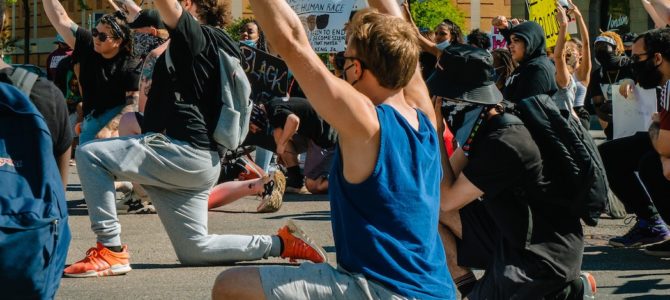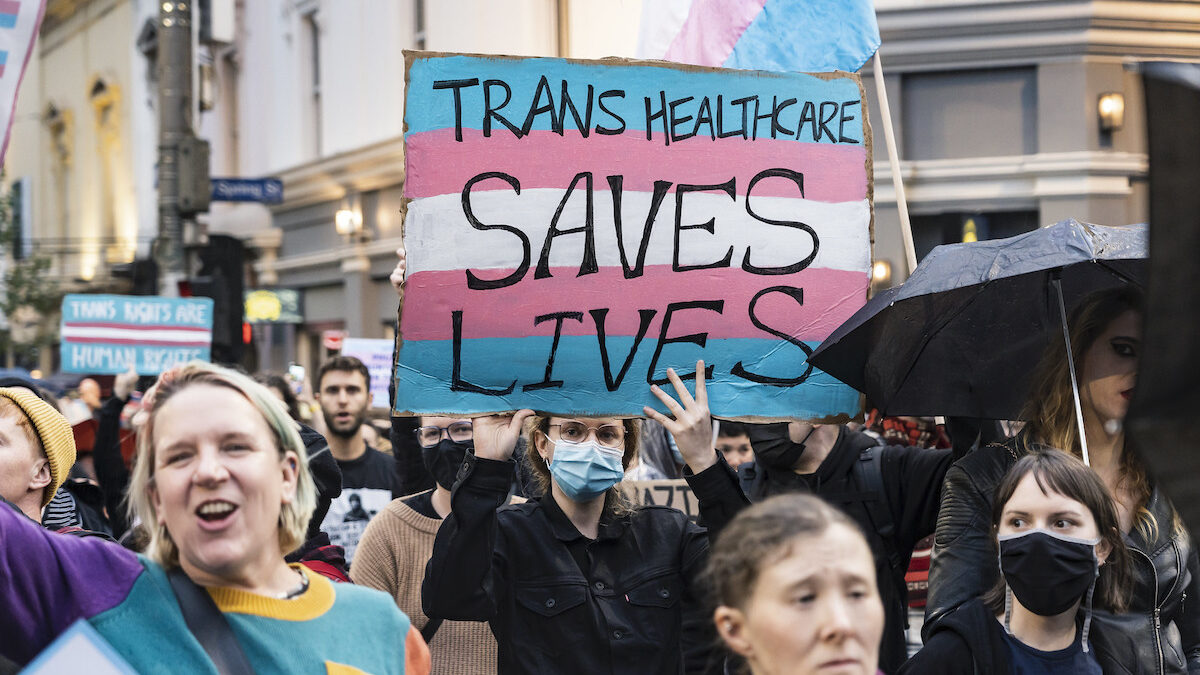
For years now, pollsters and demographers have been chronicling the decline of religion in America. And it’s not just religious affiliation that’s declining. Along with lower rates of church attendance, religious weddings and religious activities in the household are also waning. By every measure, America is becoming a less religious country, with huge implications for our political and cultural life.
But the story of the decline of religion in America is incomplete. What has gone less noticed, and less studied, is the rise of ersatz religions in America—secular substitutes for traditional forms of faith. The fastest-growing of these pseudo-religions occupy either end of the political spectrum, and are themselves explicitly political. They are also dangerous cults with almost no redeeming qualities, and if left unchecked will inspire their adherents to commit violence. In some cases, they already have.
On the right, there’s the big-tent conspiracy theorists of QAnon, a kind of gnostic quasi-religion centered on the struggle between Trump and a shadowy “deep state” comprised of wealthy global elites, celebrities, and politicians—although QAnon, as its followers will tell you, encompasses much more than just Trump. (It’s worth noting that the mainstream press loves to publish long-winded essays holding up QAnon as evidence that Trump supporters are conspiracy-addled rubes while ignoring the extent to which outlandish conspiracy theories like the Russia collusion hoax are still accepted by the liberal media.)
On the left, there’s the entire institutional edifice of critical social justice theory, or what we’ll call the Cult of Woke, the most visible manifestation of which is perhaps the Black Lives Matter agenda, whose most fervent adherents come predominantly from academia, Hollywood, and corporate America. Here we should distinguish between the BLM movement broadly, which consists of a lot of suburban educated people who vaguely sympathize with antiracism, and the BLM organization and agenda, which is explicitly Marxist and incompatible with constitutional democracy, individual rights, and equal protection under the law.
Both of these forms of pseudo-religion offer ironclad answers to questions about what’s wrong with the world and what to do about it. But unlike established religions, they have obvious and sometimes menacing political undertones, and their effects on civic life are not salutary. You won’t see BLM activists or members of QAnon feeding the poor or ministering to the sick as an expression of their beliefs, but you will see them burning down buildings and planning terrorist-style attacks.
Both Left And Right Operate In Alternative Universes
Although QAnon and the Cult of Woke are both expressions of a kind of secular faith, it’s hard to imagine two more divergent strains of pseudo-religion, not just in the content of their dogmas but also in the demographics of their adherents. QAnon espouses a loose collection of conspiracy theories so sprawling and fluid that as long as you believe in some sort of conspiracy involving Trump battling nefarious global elites, you can find a place in it. It’s a big-tent cult, more Pentecostal than parochial, and its adaptability and ambiguity enable it to withstand debacles like Pizzagate.
By contrast, the Cult of Woke is more dogmatic and puritanical. Its rules might not be consistently applied, but its punishments are severe and decisive. If, for example, you are deemed to have demonstrated an insufficient level of commitment to Black Lives Matter, you can lose your job. This is what happened, for example, to the president and board chairman of the Poetry Foundation who resigned in June after 1,800 members signed a protest letter condemning them because the statement they released in support of Black Lives Matter wasn’t long enough. Countless examples like this abound across many different industries and professions, but especially in academia and the media.
What these cults share is a belief in a millenarian struggle in which the faithful sweep away the wicked, and an epistemological certainty that makes debate impossible. The Cult of Woke rejects reasoned debate explicitly. James Lindsay, who has become an indispensable scholar and explainer of critical theory, has a recent post about why the woke won’t debate you, in which he explains, at length, the epistemic closure at work.
It’s far worse than the way QAnon conspiracy theorists think about the world. Conspiracy theorists might not debate you because they think you don’t have all the information they do, or because they think you’re being hoodwinked by the media, or because they think you’re acting in bad faith and just trying to make fun of them. Rejecting objectivity and reasoned debate is therefore a baked-in feature of a movement based on ever-shifting conspiracy theories, many of which haven’t panned out as predicted. In that sense, it’s fundamentally defensive.
By contrast, the members of the Cult of Woke take an offensive approach. They see no point in debating the unwoke, explains Lindsay, because
they have accepted the belief that we operate within a wholly systemically oppressive system. That system extends to literally everything, not just material structures, institutions, law, policies, and so on, but also into cultures, mindsets, ways of thinking, and how we determine what is and isn’t true about the world. In their view, the broadly liberal approach to knowledge and society is, in fact, rotted through with ‘white, Western, male (and so on) biases,’ and this is such a profound departure from how the rest of us—broadly, liberals—think about the world that it is almost impossible to understand just how deeply and profoundly they mean this.
Put another way, QAnon adherents aren’t calling into question how we know things, they’re positing that you, the uninitiated, know the wrong things. You’ve been lied to about the facts, and once you know what they know, you’ll see the world as they do. It might be laughably wrong, and sometimes even dangerous, but at least the pseudo-religion of QAnon accepts the liberal premises of western civilization.
The woke reject the liberal notion of “facts” entirely. That’s why, for example, the Smithsonian came out with a racist curriculum earlier this month for the National Museum of African American History and Culture that included a chart explaining “aspects and assumptions of whiteness,” including things like “objective, rational thinking,” “cause and effect relationships,” and “quantitative emphasis.” Even concepts like delayed gratification and time itself were, according to the museum, marks of whiteness.
According to this worldview, everything must be reinterpreted according to the dogma of critical theory, including the value of a person. Instead of the essentialism of man as a rational created being, the Cult of Woke posits the essentialism of man as merely a racial being.
Hence, to take just one recent example, you have Rep. Alexandria Ocasio-Cortez last week calling a statue of Saint Damien of Molokai in the U.S. Capitol building an example of “white supremacy.” The example stands out because Father Damien’s life and work was an example of the opposite of white supremacy. A Catholic priest from Belgium, he died of leprosy after spending his life serving in a leper colony in the Kingdom of Hawaii.
The only way to explain this disconnection from reality is to understand that the Cult of Woke isn’t just positing that there is injustice in the world, it’s positing that in order to see the injustice you have to accept a new version of reality. As Lindsay notes, the woke see the world according to race and systems of power, dividing everyone into oppressed or oppressor, neither of which are even aware of the systemic forces that pit them against one another. They just accept it as normal and natural, and hence live in a “false consciousness.”
The only way to escape this false consciousness is to become woke, which means, among other things, rejecting the systems that created all this oppression and gaining what they call critical consciousness. “Adherents to this worldview will not want to have conversations or debate with people who do not possess a critical consciousness because there’s basically no point to doing such a thing,” writes Lindsay.
Secular Religions Are a Misguided Cry for Community
We know where such thinking eventually leads. In an astonishingly short period we’ve seen it progress on the left from the wanton destruction of monuments to organized attacks on the American Founding to armed insurrection, rampant violence, and mass rioting. On the right, QAnon has gone from an obscure thread on 4chan in 2017 to a global movement with deadly real-world consequences, with multiple adherents arrested for acts of violence.
Why is this happening now? While no one factor can explain the rise of these pseudo-religions, they clearly fill an unrequited desire for community and common purpose.
A recent article in Vice on the spread of QAnon communities overseas makes this point explicitly. The author interviews a man named Travis View, co-host of the popular U.S. podcast QAnon Anonymous, who explains that “whatever sort of conspiratorial beliefs that you happen to latch on to, you’re going to find a home within QAnon.” But he goes on to say, “What people get attached to more than anything else is the online community of people who don’t trust any kind of institutional knowledge.”
It’s not the conspiracies that draw them in so much as the community of like-minded people to which they can belong. For an online movement that began with the premise that Trump is battling the deep state, it’s telling that QAnon communities are sprouting up in the United Kingdom, Canada, Germany, Russia, and Indonesia—all slightly adapted to find purchase in those far-flung nations. What they have in common, if nothing else, is a sense of community. Even QAnon’s unofficial and somewhat creepy slogan, “Where we go one, we go all,” or #WWG1WGA, speaks to the solidarity of the movement.
I saw this dynamic first-hand at a Trump rally in Houston in 2018. After the rally, I happened upon a group of people hanging out in camping chairs outside the arena, talking and laughing like old friends. But these people had only just met each other in person for the first time that night.
They were adherents of QAnon, and had come from all over the country to meet at the Trump rally. They hailed from all walks of life but seemed to find meaning and purpose in their shared convictions about what QAnon had revealed to them. I asked about Trump, and one woman told me, “We support Trump, for sure, but Q is about much more than Trump. It’s about… everything, really. It’s about the truth.”
The same could be said for the Cult of Woke. The rampant rioting and violence in places like Portland, Seattle, and Minneapolis can sometimes eclipse the strong religious and communal aspects of woke activism—the kneeling, the public confessions of guilt, the outing of “heretics,” the millenarian calls for the destruction of the system and the ushering in of a just and equitable world. Scenes of activists dancing, playing music, and marching together belie a kind of desperate jubilation to the struggle, a celebration of the righteousness of their cause amid their righteous anger.
This yearning for community, for belonging, is a vital and undeniable part of the human condition. In America, it used to take the form of organized—sometimes loosely organized—religion, and to a large extent it still does.
But that’s changing. Americans might not be trending toward irreligion so much as gravitating toward secular quasi-religions like the ones described here. We need therefore to understand the rise of movements like QAnon and the critical social justice theory for what they are: cries for community, and meaning, and purpose, all driven by a burning desire to lay hold of something that is true—even if, in the end, all they have to offer is a pack of lies.









